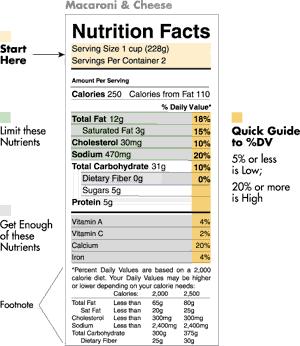BACK
to FAQs
Dietary Recommendations
There is no Recommended Dietary Allowance (RDA) for sodium.
However, the National Academy of Sciences has established that healthy
adults need a minimum of 500 milligrams (mg) of sodium per day, and the
American Heart Association (AHA) recommends that
sodium intake should be less than 2400 mg per day. The food labeling
rules of the U.S. Food and Drug Administration (FDA) state that the Daily
Value (DV) for sodium is 2400 mg. The National High Blood Pressure
Education Program also recommends that, as part of an overall healthy diet,
Americans should consume no more than 2400 mg of sodium per day (about
6 grams of salt.)
In their statement on sodium intake
and high blood pressure, the National Heart Lung and Blood Institute (NHLBI)
suggest that all Americans moderate salt intake to help prevent and treat
hypertension (high blood pressure) (http:www.nhlbi.gov/new/press/17-1998.htm).
When viewing the contents of this page, keep in mind that
depending on your health status, these tables may or may not apply to you.
For example, salt-sensitive individuals with hypertension (high blood pressure)
are often recommended to choose a low sodium diet. Consult your health
care provider before making any drastic dietary changes.
| Estimated
Age
0-5 mo.
6-11 mo.
1 yr.
2-5 yr.
6-9 yr.
10-18 yr.
>18 yr. |
Sodium Minimum Requirements
Weight (kg)
4.50
8.90
11.0
16.0
25.0
50.0
70.0
|
of Healthy Persons
Sodium (mg)
120
200
225
300
400
500
500
|
(Contemporary Nutrition: issues and
insights/Gordon M. Wardlaw, Paul M. Insel, Marcia F. Seyler, 2nd ed., Mosby-Year
Book, Inc.1994)
US
Departments of Agriculture and Health and Human Services:
US
DIETARY GUIDELINES FOR AMERICANS 2000, 5th EDITION
|
Aim For Fitness:
1. Aim for a healthy weight.
2. Be physically active each day.
Build a Healthy Base:
3. Let the Pyramid guide your food choices.
4. Choose a variety of grains daily, especially whole
grains.
5. Choose a variety of fruits and vegetables daily.
6. Keep food safe to eat.
Choose sensibly:
7. Choose a diet that is low in saturated fat and
cholesterol and moderate in total fat.
8. Choose beverages and foods to moderate your intake
of sugars.
9. Choose and prepare foods
with less salt.
10. If you drink alcoholic beverages, do so in moderation. |
American Heart Association:
DIETARY GUIDELINES FOR HEALTHY ADULT AMERICAN 1999
|
1. Saturated fat intake should be 8-10% of calories.
2. Total fat intake should be less than 30% of calories.
3. Polyunsaturated fatty acid intake should be up to 10% of calories.
4. Monounsaturated fatty acid intake should make up to 15% of
calories.
5. Cholesterol intake should be less than 300 mg per day.
6. Carbohydrate intake should make up 55-60% or more of calories
with emphasis on increasing
complex carbohydrates.
7. The sodium intake should be less
than 2400 mg per day, which is about 1 1/4 teaspoons
of salt.
8. Total calories should be adjusted to achieve and maintain
a healthy body weight. |
Food
and Nutrition Board, National Academy of Sciences:
DIETARY GUIDELINES FOR DIET AND HEALTH 1992
|
1. FAT: Reduce total fat intake to 30% or less of calories.
Reduce saturated fat to less than 10%
of calories.
Reduce cholesterol intake to less than
300 mg daily.
2. Eat five or more servings of vegetables (especially
green & yellow) and fruits (especially citrus)
daily.
3. Increase intake of starches and other complex carbohydrates
by eating six or more daily
servings of breads, cereals and legumes.
4. Eat a moderate amount of protein (i.e. 6 ounces of meat
or equivalent a day).
5. Balance the amount of food with exercise to maintain
appropriate body weight.
6. Alcohol is not recommended; however limit daily consumption
to two cans of beer, two small
glasses of wine or two average cocktails.
Pregnant women should avoid all alcoholic drinks.
7. Limit salt to 6 grams (slightly
more than one teaspoon) daily.
8. Maintain adequate calcium intake.
9. Avoid taking dietary supplements in excess of the US
RDA in any one day.
10. Maintain optimal level of fluoride. |
 |
|
|
The % Daily Value (DV) indicates, for those who eat
2,000 calories a day, how much of the recommended amounts is provided in
one serving of the food.

Your daily amounts may vary depending on the calories
you eat in a day.
|


